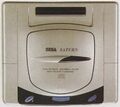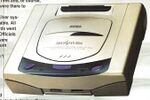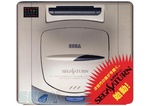History of the Sega Saturn/Development
From Sega Retro
Rumours of a successor to the Sega Mega Drive emerged as early as 1991, with the arrival and subsequent rise of Nintendo's Super Famicom in Japan. The Super Famicom, later to become the Super Nintendo Entertainment System (or SNES) in western markets, was considered by much of the press to be the superior machine from a technical standpoint, prompting suggestions that Sega may have attempted to leapfrog its competition at the earliest possible opportunity.
The industry was still relatively young and the concept of a console "cycle" had not yet fully been explored, and the arrival of the Sega Mega-CD put the question of a successor to bed for several months. However, in 1993 the situation was different - threats of the Atari Jaguar, CD-i and 3DO were putting strain on the Mega Drive's 16-bit image in the West, and in Japan, the system simply had not taken off, and so, talk of brand a new console began to make the headlines - "project Saturn".
Contents
Pre-announcement
A 27-member group of Sega staff began development of the "Saturn" project - a CD-based gaming system to carry the company forward. The team was composed of Sega employees from a wide range of specialities, including hardware engineering, product development, and marketing, and was headed by Hideki Sato, who had also been responsible for designing Sega's prior "main" consoles. The team worked roughly two years on the project exclusively, in an attempt to get the console to launch with the some of the world's best hardware and software of the era.
Throughout much of 1993, nobody knew what project Saturn entailed, though from the start it seemed likely that the successor to the Mega Drive would be a "32-bit" or "64-bit" system utilising a CD-ROM drive and possibly offering a cartridge option (though no Mega Drive backwards compatibility). It was often difficult to envision the future - Virtua Racing and later Virtua Fighter gave clues about what 3D gaming from Sega could look like, but expectations were raised when Namco demonstrated its texture-mapped arcade racing game, Ridge Racer at the Amusement Machine Show 1993.
Sega of America began talking openly of 32-bit systems in the Summer of 1993, with Tom Kalinske outlining Sega's existing track history of 32-bit arcade machines and claiming the company could release a machine "tomorrow" if they wanted.[1] However, the major hurdle was price - Kalinske did not want to market a machine that would cost over $500, and hardware prices were not set to drop to acceptable levels in 1993 (or 1994).
EGM reported that this new Saturn project was likely to use a Motorola 68030 processor. It also became increasingly unlikely that this new project would not be compatible with Mega Drive or Mega-CD software[2].
More information was leaked shortly afterwards, suggesting the Saturn was a 32-bit machine running on a single NEC V60-esque processor clocked at 27 MHz. Suggested specifications included a palette of 16.7 million colours, an alpha channel for sprites, and the capability of displaying and animating over 16,000 polygons on screen at once (per frame, equivalent to 480,000 polygons per second at 30 frames per second). The asking price was calculated at around the $400 USD mark.[3]
On September 21st, 1993, Sega announced a joint venture with Hitachi with the intention of producing a "32-bit" video game multimedia machine, the idea being that Hitachi would be responsible for producing the processor. Mega Drive and Mega-CD support was effectively ruled out around this point - it was unlikely that Sega would equip its new console with all the chips required to run this software natively, and more modern techniques such as software emulation was completely unheard of at the time.
By February 1994, talk of the Saturn was well under way, with developers supposedly receiving extremely early hardware reported to be vastly superior to the Amiga CD32, Atari Jaguar and 3DO, as well as Virtua Racing. It was thought to be more in-line with Sega's Daytona project (the corporation's answer to Ridge Racer), though these comparisons with Sega Model 2 hardware were often generous to the Saturn. Furthermore, Virtua Racing actually has a higher polygon count than Daytona, but because the polygons are not texture-mapped (which, incidentally was technology provided by Lockheed Martin, not Sega), the game looks less "realistic".
Edge magazine issue #5 states that the Saturn had a SH7032 CPU RISC chip running at 27MHz as its main processor, 3MB of RAM (which suggests a lack of VDP2 chip), "32 audio channels" (with support for PCM and FM) and a release date of November 1994[4]. Electronic Gaming Monthly also suggested the Saturn was set to have a 64-bit graphics chip[5]. The final model opts for two SH-2 processors, with the SH-1 reduced to controlling the CD-ROM drive.
Coincidentally, Sony's "PlayStation X" or "PS-X" project was in a similar situation to the Saturn, though most commentators, including Sega, suggested the PS-X would be the more powerful system. Most notably, Namco pledged their allegiance to the hardware early on, with the aim of bringing Ridge Racer to this new home platform relatively unscathed.
Concepts
US Opinion
Tom Kalinske was reportedly never impressed by the plans for Saturn hardware, but Sega of Japan refused to give the American branch of Sega much say in regards to the console's development. Kalinske did not see the Saturn as a console that could sell in the region in its current form - it was not engineered in such a way that would appease Western developers, and he was fearful that the competition would eat into Sega's market share relatively quickly (at numerous points in the first half of the 1990s, the Mega Drive (or Genesis) was the best selling home video game console in North America).
Silicon Graphics
Kalinske even went so far at one stage to source out an alternative graphics chip, approaching James H. Clark of Silicon Graphics (SGI), who, along with the recently acquired MIPS Computer Systems, were working together to create a low-cost real-time 3D graphics system[6]. Negotiations fell through - though Sega of America were positive about the project, Sega of Japan were not keen, with the company collectively evaluating an early prototype as having several unresolved hardware-issues and deficiencies which made the project too risky. Sega would have also demanded exclusive rights to the upcoming chip, while SGI wanted to license the technology to other vendors.
The Silicon Graphics deal is controversial, not least because it was picked up by Nintendo for use in the Nintendo 64 in the Summer of 1993.
Sony Deal
Having been more-or-less rejected by Nintendo, Sony Electronic Publishing turned to Sega of America for help get into the console race. The PlayStation project (or what would become the PlayStation) was not thought highly of by Sony executives in Japan (a view which would not change until E3 1995), and Sega of America, reportedly impressed by the PlayStation project were keen to get Sony on board to create a Sony-Sega console[6]. Japan once again rejected the idea based on Sony's perceived inexperience, however Sony Imagesoft, along with Sega of America would work with Digital Pictures to test out CD-based game development prior to the deal's collapse.
Inevitably Sony would hire Steve Race who was working under Tom Kalinske at the time and challenge Sega head-on at E3 1995.
Akitoshi Oikawa patent
Akitoshi Oikawa of Sega filed a patent (number USD362869 S) of what is presumed to be a cartridge-less Saturn console in early 1994[7]:
Winter CES 1994
First public viewings of Project Saturn emerged at Winter CES 1994[8], held in January, but it was not the focus of Sega's efforts, being shown extremely briefly on a marketing loop with many Mega Drive and Mega-CD titles. No details of the hardware were mentioned, just a rolling demo of five potential Saturn games - Virtua Fighters and Daytona GP (using arcade footage) and three early tech demos - Virtua Soccer, "action game" (Clockwork Knight) and "3D shooting game" (Panzer Dragoon)[9].
The console itself resembled something very similar to the final product, but was partially obscured by darkness and not rendered in full colour. It may not have even been a physical product at this stage, just a glorified piece of concept art.
Imagina 94
On the 16th of February, the Saturn made another appearance, this time at Imagina 94, the "13th international forum on computer graphics, virtual worlds and special effects"[10] at the Monte-Carlo Convention Center in Monaco. At around 3PM in the afternoon, Yuzo Naritomi held a conference (called "Virtua Sega") detailing some basic specifications of the console as it stood at the time.
However, as the conference name may have suggested, most of what was on display, including renders of the console itself, had been produced with top-end Silicon Graphics hardware. The contents were otherwise similar to that of Winter CES.
Jupiter and Mars
Alongside project Saturn, Sega were working on a project Jupiter - a cartridge-based 32-bit system. The main difference between the two was a CD-ROM drive - at one point, the Saturn set to be able to run cartridge as well as disc-based software, with the cartridge port later being downgraded into a feature which would "assist" games. The Jupiter project was essentially a Saturn without a CD-ROM drive, but could have been upgraded at a later stage to create a makeshift Saturn console[11].
By February 1994 the Jupiter had been publically axed and in its place, the ill-conceived "project Mars", headed by Sega of America[12]. Seemingly unaware of the upcoming Saturn hardware, the project, later known as the Sega 32X, set itself the task of extending the Mega Drive's lifespan, first as a true successor to the system, then as a hold-over to the Saturn. As a result, many early Sega "32-bit" projects have a confused development history - some were converted into Saturn games, others were mislabeled as Saturn software, and many projects were never completed.
Like the Saturn, the 32X saw its own share of bodged upgrades, having originally been envisioned as little more than a colour palette boost for the aging Mega Drive. It acquired two SH-2 32-bit processors, identical to those of the Saturn (albeit clocked at a lower rate) leading to misreported claims of Saturn compatibility[13]. The Saturn had a cartridge slot, the 32X used cartridges, and in Japan these two Sega-produced "32-bit" systems were released within a month of each other - compatibility seemed obvious, and yet there was none.
The 32X created a great deal of customer divide - it was an expensive and cumbersome unit, and was discontinued in less than two years, damaging both consumer confidence and future Saturn sales. While the add-on is not thought to have influenced the Saturn's design, it cultivated scepticism among the press and consumers - maintaining two systems was untennable, and if faced with pressure from its rivals, it was widely feared Sega might pull a similar stunt in a year or two's time.
Consumer Group Show Spring 1994
March 1994 is where Japanese consumers could "see" a real Sega Saturn. A handful of hardware photos and a logo were sent to the press, while TBS Television aired footage of the Saturn at Sega's R&D labs. Hayao Nakayama had the honor of revealing the system to the world, though as it transpires, the Saturn on display was merely a painted shell constructed out of wood[14].
Nevertheless, footage showed prototype Saturn hardware running Virtua Fighter.
The Saturn model on display was much like the final Japanese HST-0001 console, spare for one key difference - it was silver as opposed to grey. Also printed on the unit was the text "High Performance CD-ROM/Cartridge Entertainment System", suggesting that cartridge-based software was still being considered at this stage.
Tokyo Toy Show 1994
The Toyko Toy Show 1994, held on the 2nd of June 1994, finally let people use the console. Though mostly complete in design, the Saturn hardware had yet to be condensed into its final form, and while a Saturn console was put on display, this consisted solely of a plastic shell. Alongside the Saturn, prototype control pads and Virtua Sticks were put on display, with both undergoing cosmetic changes before release.
The event featured a number of early Saturn games, although with the exception of a 30% complete build of Virtua Fighter, most were said to be unplayable[15]. Technical demos featuring content from what would emerge as Daytona USA were featured, and Victory Goal and Clockwork Knight also showed up in some form[16]. Many games were announced, but much of the attention went to Sony's PlayStation, now in its near-final incarnation.
EGM² reported that the Saturn was due to retail at ¥49,800 or less, would have two SH-2 32-bit RISC CPUs, have a Motorola 68000 chip driving the sound and could handle 16.77 million colours[17]. Flat shading, gourard shading and texture mapping were all set for 3D models, and scaling, warping and rotation were set for sprites. Five layers of scrolling were available for 2D graphics, and 32-channel PCM and 8-channel FM audio were available. These figures suggest that the hardware was roughly the same as the final Saturn model, though with some figures missing, there is the possibility of slight differences. The final cost of the Saturn in Japan was ¥44,800, reduced primarily to compete with the PlayStation.
This Saturn is very similar to the previous one but now has its final logo, even if the shell is still silver. Sega also claimed 178 third-party developers were now backing the Saturn (versus the 164 third-parties announcing PlayStation support back on the 10th of May)[18].
It is also notable that the Saturn's launch was deliberately delayed around this period for Western markets - a strategy ensuring the console would have more software at launch, as in both the Saturn and PlayStation's case, third-party support had yet to pick up.
Final Design
Towards the end of 1994, having spent much of the year focusing on the 32X instead of the Saturn, Sega of Japan announced a final tweak to the console's aesthetics, claiming their new grey model was more universal than the silver of before (though it is thought that in reality, the silver scratched too easily)[19]. It was at this point where the deals with Hitachi and JVC came in, with the concept of manufacturers making their own Saturns, similar to the plans of the now struggling 3DO console.
Hitachi also owned their own retail outlets at the time, so it was an excuse to get the Saturn onto more store shelves in Japan.
At the second CSG show of the year, the Saturn's release date was finalised for the 22nd of November[20] - eight days before the previously announced PlayStation date.
References
- ↑ File:EGM US 050.pdf, page 54
- ↑ File:EGM US 052.pdf, page 66
- ↑ File:MeanMachinesSega11UK.pdf, page 8
- ↑ File:Edge UK 005.pdf, page 6
- ↑ File:EGM US 053.pdf, page 69
- ↑ 6.0 6.1 Interview: Tom Kalinske (2006-07-11) by Sega-16
- ↑ https://www.google.com/patents/USD362869
- ↑ File:EGM US 056.pdf, page 58
- ↑ File:Edge UK 006.pdf, page 7
- ↑ File:PlayerOne FR 040.pdf, page 8
- ↑ File:Edge UK 007.pdf, page 6
- ↑ File:Edge UK 008.pdf, page 6
- ↑ File:SegaPower UK 62.pdf, page 6
- ↑ File:Edge UK 009.pdf, page 6
- ↑ File:EGM2 US 01.pdf, page 106
- ↑ File:Edge UK 011.pdf, page 7
- ↑ File:EGM2 US 01.pdf, page 108
- ↑ File:Mega UK 23.pdf, page 25
- ↑ File:Edge UK 014.pdf, page 13
- ↑ File:Edge UK 015.pdf, page 14







